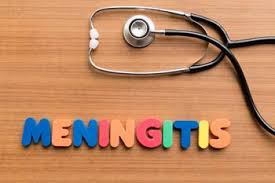HEALTH TIPS: Some natural cures for meningitis

HEALTH TIPS:
Some natural cures for meningitis
CEREBROSPINAL meningitis, a team leader of hot weather diseases in Nigeria, is striking again with characteristic deftness.
This time, it has swept through northern parts of the country as usual and is hitting at the South-western states which had always appeared immune to it. Two weeks ago, about 20 deaths were reported in the South-west alone. This is a season I do not wish to be in the north. And now that the South-west, too, is becoming a ‘no go’ area, I may become boxed in Lagos until the dust settles and the cloud clears.
Cerebrospinal meningitis is inflammation of the meninges, the membrane which covers the brain and the spinal cord. It may be caused by one or a combination of many factors which may include…viruses, bacteria, fungi, protozoa, mycobacterium,tuberculosis and non-infectious agents such as cancer cells which spread to the meninges, vasculitis (inflammation of blood vessels), Lupus erythematosus, Non steroidal Anti-inflammatory Drugs (NSAIDs), some antibiotics and intravenous immunoglobins et.c.
There is a cerebromeningitis belt in Sub-Saharan Africa of which some states in northern Nigeria are a portion. Now, it would appear some south-western states are becoming a part of the annexture. The disease may strike in its season or off season, especially in careless people. By careless people is meant people who do not give deserved attention to small health events which can be nipped in the bud to prevent an escalation. One of such people may be a young woman who telephoned me for help last week. She was challenged with what a few days earlier I had seen to be a clear case of post nasal drip. As she sat across the desk in my office, her nostrils discharged fluid like a dripping tap. That was a clear case of bacterial, viral or fungal infection. It may respond positively to nasal drops or sprays of garlic oil, Oregano oil, Colloidal silver or even Golden seal powder or Mango seed powder extract solution in water improvised as a nasal drip in a bottle designed for that purpose. She had no access to any of them, and her condition worsened. Her nasal discharge began to smell, in her own words later on, “like rotten egg”. She could not attend to her business as many people complained about the odour.
If the germs escaped from the nasal cavities, they could travel to the eye socket, the ear canals or to the meninges causing inflammation, pain, bleeding or even death, depending on the severity. Some cases of cerebrospinal meningitis may cause deafness, epilepsy, hydrocephalus or memory problems. Adult victims of this disease often present severe headache in about 90 percent of attacks caused by bacteria. Muscles of their necks may become rigid. High fever and mental weakness may join the train. The adult sufferer may, in addition, suffer from sensitivity to light (photophobia) or sensitivity to sound (phonophobia). Infected children may not present these adult symptoms. Children may simply become irritable and look unwell. A bulge may be seen in the fontanel of a baby of about six months. The fontanel is that soft spot on a baby’s head which mothers often dab with olive oil or coconut oil. Presentation of leg pains and abnormal skin colour may also be exhibited by children.
Other symptoms abound that are too many to mention here. For example, some types of this infection produce rashes which, in some cases, have led to complications that would cause gangrene and warrant amputation. There may be sepsis, systemic inflammatory response syndrome, extremely low blood pressure, low or high temperature, blood clotting, poor blood circulation, bleeding, swollen brain pressure, extrusion of swollen brain matter through the base of the skull. Increased pressure in the inflamed brain may cause seizures. Cranian nerves may become so negatively affected that the effect may be noticed in hearing loss, eye movement and awkward facial contour. When the brain is inflamed, (encephalitis) or the brain’s blood vessels (cerebral vasculitis), like the production of blood clots in the brain (cerebral venous thrombosis) may negatively affect parts of the body which these affected parts of the brain control.
Natural cures
The treatment and cure of cerebrospinal meningitis follows the pattern of the causative agents and the symptoms it presents. As this condition is caused by bacteria, viruses, parasites, and, possibly heavy metals as irritants, among many more potential agents, these possibilities should be addressed, so should immune depletion and nutritional deficiencies or imbalances. Literally speaking, there are a thousand and one solutions, some of which are mentioned in passing below.
Chlorella
This is a blue-green alga packed with chlorophyll, the green portion of plants which gives them the power of photosynthesis. Chlorophyl has capacity to unite the forces of nature in the soil and air to make food and herbs for man, and store oxygen. Dr. Bernard Jensen, one of Europe’s doctors who heals with fruits, vegetable juices and herbs, says of chlorella:
“Chlorella is an edible alga loaded with nutrients, very high in vitamin B12 as well as in the nucleic factors that help us stay young, and has a growth factor that stimulates healing.
From many studies, we learn that chlorella cuts high blood sugar and high blood cholesterol and supports weight loss efforts. We know, also, that it supports immunity and the everyday internal war on germs. This starts with the saliva. In saliva, there is an immune defence substance called Immunoglobin A (SLGA). This is the first line of immune defence for everyone. SLGA kills all germs which enter the body through food, water or air. But stress and exercise deplete its count.
People who easily contract infections are, therefore, most likely to be SLGA-deficient. People who suffer from digestive problems need to check their SLGA profiles. For these problems come often from low-grade viral infections which, overtime, may have depleted SLGA stores as the body battles the viruses. It is often reported that digestive health disorders such as this encourages germ-gang actions in many parts of the body, whether it is tonsilitis, vaginal candidiasis and other issues, mouth problems and bacterial gang-germs overgrowth. These germs can cause cerebrospinal meningitis if they find their ways to the brain and the spinal cord.
Chlorella can check this malaise because it can boost SLGA production and dis-arrange the supply-line of these germs. In a human study in which 5000mg of chlorella powder was given to the subjects everyday, chlorella suppressed histamine release, raised the levels of Interleukin-12 and interferon-Y, both of which support immune signalling.
In another study, chlorella again raised these counts and the production of Natural Killer (NK) cells, which challenge infections and even kill cancer cells.
Chlorella is a chlorophyll-rich alga. About 50years ago, science found that this green substance (chlorophyll) kills bacteria whether in the mouth, throat and in the intestine. Streptococus and staphylococus yield to it. Chlorophyll heals the injuries they cause by helping the regrowth of connective tissue. Dr. E. Bercher, a leading researcher, says of chlorophyll:
“It increases the functions of the head, affects the vascular system, the intestines, the uterus and the lungs. It raises nitrogen exchange and is, therefore, a tonic which, considering its stimulating properties, cannot be compared with any other. “With these attributes of chlorella, it should be a wonderful ally in the fight against germs.
Colloidal silver
This broad spectrum anti-microbial is said to work by disabling the enzyme one-celled bacteria, viruses and fungi require to metabolise oxygen. Without hurting the human body, colloidal silver, thereby, suffocates these germs. Before 1938, colloidal silver was used by doctors in the fight against germs. Even medical lay people in their homes placed silver dollar coins in milk to elongate its shelf life. With the discovery that silver as medicine would work better, it became necessary to upgrade silver medicine to colloidal medicine. Colloidal means very fine particles. The body’s fluids are colloidal in nature and so should be medicine. Making silver colloidal was expensive and this put off the big pharmaceutical companies, which easily turned to inexpensive drugs.
We must thank Dr. Robert O. Becker for the availability of colloidal silver today. He is the author of THE BODY ELECTRIC. In the 1970s, he studied regeneration of limbs, spinal cord and organs. He found that silver ions promote bone growth and killed bacteria which surrounded them. In its March 1978 edition, SCIENCE DIGEST would report in an article titled OUR MIGHTIEST GERM FIGHTER:
“Thanks to eye-opening research, Silver is emerging as a wonder of modern medicine. An antibiotic kills perhaps a half dozen different disease organisms, but silver kills some 650. Resistant strains fail to develop. Moreover, silver is virtually non-toxic.”
That article was concluded with a statement by biochemist Harry Margraf, a pioneering silver researcher under Carl Moyer, M.D., chairman of the department of surgery at the University of Washington in the 1970s. He said: “silver is the best all-round germ fighter we have.”
Some of the colloidal silver taken orally may enter the bloodstream from under the tongue, stomach and intestine, it goes into tissues and organs where, between three and four days, they accumulate in sufficient quantum to be effective. When it comes near germs, it makes them unable to “breathe” but does not hurt human cells. If one is very ill, one may take up to two to three times the nutritional maintenance dosage of about one to four teaspoonfuls a day.
Myco
This product is designed for myco-plasma germs. These are small bacteria that are found chiefly in the limbs, urinary tracts and genital tracts but whose effects may be felt throughout the body, even in the brain where they may cause meningitis. Some users of this proprietary medicine say it cured their fibromyalgia, ulcerative colitis, Rheumatoid arthritis (RA) and Ashimotois disease, to mention a few ailments. I have suggested it, with good results, for bilateral, polycystic ovarian Syndrome and other ovarian infections. These bacteria may cause a type of pneumonia, breathing difficulty, eye pain, sore throat, headache, weakness, cough, fever, chills, joint and muscle pain and stiffness.
Sometimes, lymph nodes in the neck may enlarge, causing a scare. Pericarditis (inflammation of the sac round the heart) may occur. The Central Nervous system (CNS) may be hit as well. In this regard, Guillain-Barre syndrome may not be too far away. This is a temporary inflammation of the CNS which may cause temporary weakness and paralysis of muscles as well. There may also be encephalitis (inflammation of the brain) and meningitis (inflammation of the membrane around the brain and spinal cord). In the lower abdomen, what doctors call P.I.D. (Pelvic Inflammatory Disease) may occur. It is a common affliction of many Nigerian women who can hardly imagine what is going on in the pelvic region when the doctor diagnoses P.I.D.
Mycoplasma is present in between 30 to 50 percent of sexually active men and women. In women, it colonises the urethra (the pipe which brings urine from the bladder). This may cause inflammation of the tissue or even vaginitis (inflammation of the vagina).
Sometimes Mycoplasma may not be the cause of trouble where it colonises, but may worsen the troubles caused by other pathogens. Men and women who indulge in oral sex should recoil from it if they realise the dangers they expose their mouths and bodies to.
Echinacea/Golden seal root
I have a son who does not want me to talk about Golden seal root without adding Echinacea. He wins the argument always. Many producers of proprietary medicine join the two herbs in wedlock. But the Nigerian economy in its present state does not always favour the budget for them. I, too, agree that Echinacea in combination with Golden seal root is a double punch against any infection. Echinacea improves immunity by activating immune cells, Golden seal supports mucus flow to neutralise and take away the pathogens.
With Echinacea consumption, the production of interferon and T-Lymphocytes have been known to increase. Interferon fights viral infections. At the University of Munich, researchers demonstrated that Echinacea yielded a 30 percent output of infection-fighting T-cells more than some pharmaceutical drugs which were designed to improve immune function and response. Echinacea stimulates production of macrophages, those large white blood cells which help to keep the blood and lymphatic system clear of bacteria and viruses as well through the cortisone-like activity of one of its constituents.
Golden seal root is a friend of the mucus membrane. But it is contraindicated in large dosages and for an indefinite period of time as this may have a drying effect on these membranes. That is why it is often prescribed to be used seven days on, and seven days off for say, about two months and stopped for a “holiday”. Its major constituent is Berberine, which has been shown in many studies to be anti-infective, anti-microbial and immune stimulating. Many laboratory studies confirm that Berberine kills bacteria, fungi and protozoa such as staphylococus, chlamydia, salmonella typhi, E. Coli, gonorrhea, meningitis, candida albicans. In many studies, Berberine was found to be more effective than some antibiotics.
Garlic/GSE
We cannot forget good, old garlic. It kills germs of all sorts and is an antioxidant. Regular intake should keep the immune system on the go. GSE is grape seed extract. It is one of those substances whose molecules easily cross the tough barricade or cordon of the Blood-Brain barrier. It is an antioxidant, antibiotic, antiviral and antifungal.
Curcumin
Curcumin is the yellow substance in Turmeric, a spice that has recently become popular in Nigeria. Turmeric is a substance in curry, which Nigeria cooking of the 1960s and 1970s enjoyed before the advent of monosodium glutamate (MSG). Curcumin, the work horse of Turmeric, has been shown in many studies to lower inflammation, one of the hallmarks of cerebrospinal meningitis. Inflammation is a common factor in many diseases, low grade or high grade, and many Nigerians suffer from it without knowing they are. In metabolic syndrome, for example, it is clearly evident. This syndrome is a cluster of ailments which travel together and is often underlined with a large abdomen.
Some doctors call it SYNDROME X. It may lead to diabetes, high cholesterol level, especially the dangerous LDL (low Density Lipoprotein), stroke, high blood pressure et.c. About 117 subjects were involved in a double blind, placebo-controlled study which evaluated Curcumin’s capacity to lower inflammation. They were all diagnosed with metabolic syndrome. Half of the group took 1000mg of curcumin powder daily for eight weeks. The other half was given a placebo pill. The study ended with the Curcumin group reporting lower levels of inflammation. This included lower levels of C-Reactive Protein (CRP), an inflammation marker. Two other inflammation markers also decreased in quantum. These were fasting blood sugar and Hemoglobin A 1c (a measure of longer term blood sugar levels). Comparatively, the other group reported higher blood sugar levels and higher level inflammation. Eight previous studies confirmed the ability of curcumin to lower inflammation levels.
– The Nation





